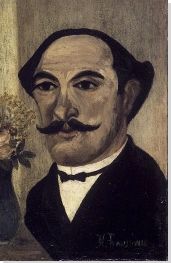Summary of Henri Rousseau
Henri Rousseau became a full-time artist at the age of forty-nine, after retiring from his post at the Paris customs office - a job that prompted his famous nickname, "Le Douanier Rousseau," "the toll collector." Although an admirer of artists such as William-Adolphe Bouguereau and Jean-Leon Gerome, the self-taught Rousseau became the archetypal naïve artist. His amateurish technique and unusual compositions provoked the derision of contemporary critics, while earning the respect and admiration of modern artists like Pablo Picasso and Wassily Kandinsky for revealing "the new possibilities of simplicity." Rousseau's best-known works are lush jungle scenes, inspired not by any firsthand experiences of such locales (the artist reportedly never left France), but by frequent trips to the Paris gardens and zoo.
Accomplishments
- Although he had ambitions to become a famous academic painter, Rousseau instead became the virtual opposite: the quintessential "naïve" artist. Largely self-taught, Rousseau developed a style that evidenced his lack of academic training, with its absence of correct proportions, one-point perspective, and use of sharp, often unnatural colors. Such features resulted in a body of work imbued with a sense of mystery and eccentricity.
- The untutored and idiosyncratic character of Rousseau's art was derided by many early viewers of his work, with one Parisian journalist memorably writing that "Monsieur Rousseau paints with his feet with his eyes closed." Yet this quality resonated with modern artists such as Picasso, who saw in Rousseau's work a model for the sincerity and directness to which they aspired in their own work, by drawing inspiration from African tribal masks and other "primitive" and traditional art forms.
- Influenced by a combination of "high" and "low" sources - academic sculpture, postcards, tabloid illustrations, and trips to the Paris public zoo and gardens - Rousseau created modern, unconventional renderings of traditional genres such as landscape, portraiture, and allegory. The fantastic, often outrageous imagery that resulted from these hybrid influences - most famously, a nude woman reclining on a divan mysteriously located in a tropical jungle - was celebrated by the Surrealists, whose art valued surprising juxtapositions and dream-like moods characteristic of Rousseau's work.
Important Art by Henri Rousseau
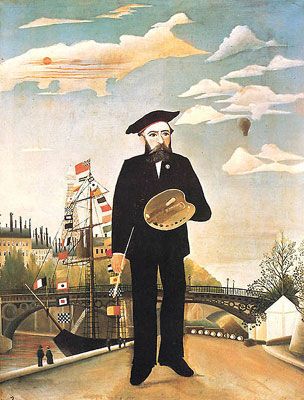
Myself, Portrait-Landscape
Here, Rousseau captures the height of greatness to which he aspired as a painter, presenting himself in outsized scale with brush and palette in hand and wearing a suit and traditional artist's beret, before a landscape that features the Eiffel Tower and a tall-masted ship decorated with world flags. Although he completed the portrait in 1890, Rousseau subsequently updated the work with additional autobiographical details: a ribbon of the order of academic distinction, which he added to the lapel in 1901, after becoming a drawing teacher at the Association Philotechnique, and the names of his two wives, Clemence and Josephine, which he later painted on the palette. Rousseau's ambitions to become a noted academic painter are also evoked in the subtitle of this work, which announces a new hybrid genre - the "portrait-landscape." A contemporary critic mocked Rousseau's self-aggrandizing portrayal in this work, writing, "I found it extremely difficult to come to terms with Monsieur Henri Rousseau whom I shall call, if I may, the sensation at the Indépendants. M. Rousseau is bent on renewing the art of painting. The Portrait-Landscape is his own invention and I would advise him to take out a patent on it, as unscrupulous characters are quite capable of using it." Rousseau proudly responded in turn, "I am the inventor of the portrait landscape, as the press has pointed out."
Oil on canvas - National Gallery, Prague

Surprised! Tiger in a Tropical Storm
In this, Rousseau's first jungle painting, a wide-eyed, tooth-bearing tiger suddenly emerges from the grass, where it has been lurking, with the waving fronds, slanting branches, rain, and dark sky indicating the storm cited in the title. The canvas was also known as "Tigers Pursuing Explorers" and "Storm in the Jungle," alternate monikers suggesting some ambiguity as to its subject matter. Exhibited at the Salon des Indépendants, this jungle scene - a theme often treated by academic artists - was ridiculed by many critics for its evident amateurish quality. Yet, for the painter and critic Felix Vallotton, the work was a " 'must-see'... the alpha and omega of painting and so disconcerting that, before so much competency and childish naivete, the most deeply rooted convictions are held up and questioned." Vallotton's description suggests the reasons Rousseau would be so highly acclaimed among modern artists of the early-20th century and later.
Oil on canvas - The National Gallery, London
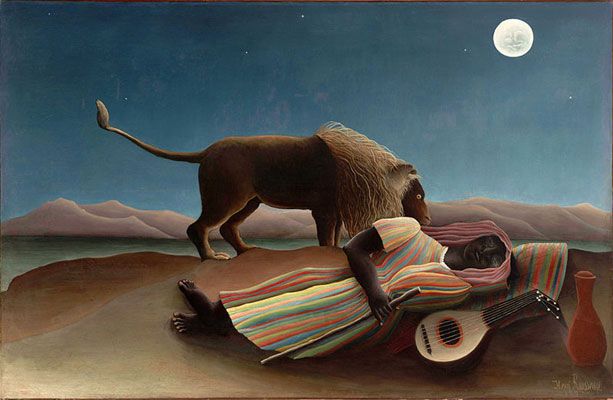
The Sleeping Gypsy
This painting's departure from Rousseau's usual subject matter led many to declare it a forgery, some even attributing it to André Derain. The moonlit scene takes place in a desert, where a female gypsy sleeps with a mandolin and jug by her side, untroubled and - amazingly - unharmed by a curious lion. The strangeness of the scene is enhanced by the precariously sloping plane and presentation of the animal and gypsy as if below the viewer's perspective. The gypsy is dressed in Eastern garb, while the painting as a whole recalls the stories from Arabian Nights, which had been translated into several unabridged versions starting in the mid-1880s. In an attempt to sell the piece to his hometown, Rousseau sent the following description to the Mayor of Laval: "A wandering negress, a mandolin player, sleeps in deep exhaustion, her jug beside her. A lion happens to pass that way and sniffs at her but does not devour her." For its eerie, meditative beauty and image of humankind's harmony with the animal kingdom, The Sleeping Gypsy has attained iconic status. It has been altered or parodied by various artists (with the lion often replaced by a dog or other animal).
Oil on canvas - The Museum of Modern Art, New York
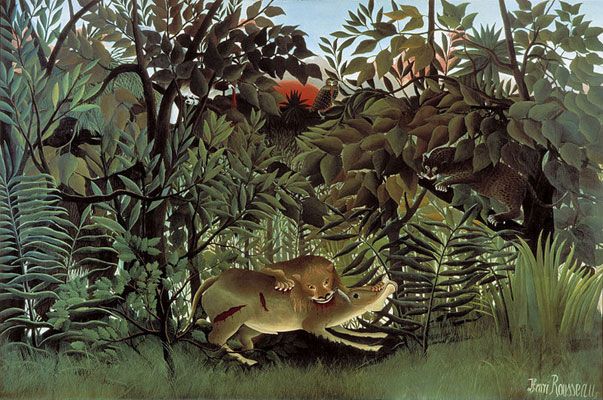
The Hungry Lion Throws Itself on the Antelope
The lion and antelope at the center of the painting wear vacant stares that contribute to a surprisingly static attack scene, much of which is taken up by lush trees before a setting sun. Rousseau based the poses of the two animals on a diorama made for the zoological galleries of the Jardin des Plantes, home to a large collection of flora and fauna often visited by the artist. With its reference to an antelope "shedding a tear," the caption that accompanied the work reveals Rousseau's lack of firsthand experience of his wild animal subjects: "The hungry lion, throwing himself upon the antelope, devours him. The panther stands by awaiting the moment when he, too, can claim his share. Birds of prey have ripped out pieces of flesh from the poor animal that sheds a tear!" Among his largest works at 83 by 122 inches and displayed at the Salon d'Automne of 1905, the painting forcefully announced the return of Rousseau's jungle scenes, from which the artist had taken a hiatus between 1891 and 1904. With its absence of three-dimensional illusionism and depiction of jungle savagery, The Hungry Lion Throws Itself on the Antelope was seen as both ancient and modern, inviting comparison to art forms such as cave painting and fresco, while demonstrating the directness of expression to be achieved from the rejection of academic artistic principles. At the Salon, the painting hung near works by artists that included Henri Matisse and André Derain, and may have prompted one keen-eyed critic to refer to the young painters as "Fauves," or "Wild Beasts."
Oil on canvas - Ernst Beyeler Collection, Basel
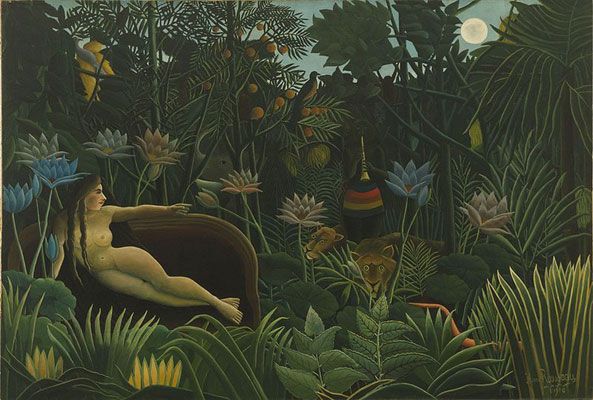
The Dream
The Dream is an apt title for the present work, with its surreal depiction of a nude woman reclining on a sofa in a forest. The woman is surrounded by colorful, painstakingly depicted greenery - which reportedly included at least twenty-two shades of green - and inhabitants of the jungle, including several wide-eyed lions who gaze at the strange scene or at the viewer. This image of a humorously out-of-place academic-style nude - reminiscent of neoclassical odalisques portrayed by artists such as Ingres and perhaps modeled on a Polish woman Rousseau once loved - in an exotic setting far from the artist's native France may be seen as Rousseau's response to late-19th-century French colonialist expansion to lands he experienced only through his visits to museums and visual media like magazines and postcards. With its incredible attention to detail, vibrant palette, and absurdist combination of imagery, The Dream reveals why Rousseau's art was so admired by the Surrealists, especially the movement's founder, André Breton, who wrote, "It is with Rousseau that we can speak for the first time of Magic Realism."
In his accompanying caption, one of the many poetic descriptions he often appended to his paintings, Rousseau described it thus:
Yadwigha, in a beautiful dream
Having fallen asleep softly
Heard the sound of a musette
Played by a kindly charmer
While the moon shone down
Upon the flowers, upon the verdant trees
The wild serpents lent their ear
To the merry tunes of the instrument.
The painting captivated the poet and critic Guillaume Apollinaire, who wrote, "The picture radiates beauty, that is indisputable. I believe nobody will laugh this year."
Oil on canvas - The Museum of Modern Art, New York
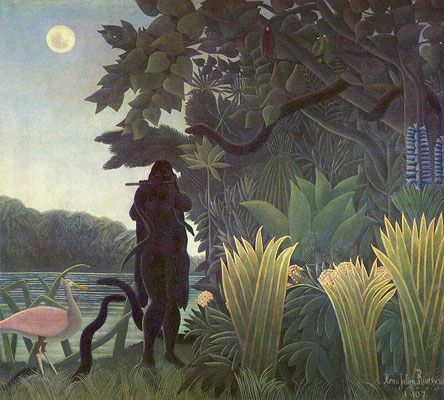
The Snake Charmer
This painting was commissioned by Robert Delaunay's mother, Berthe, Comtesse de Delaunay. Rousseau supposedly decided on the subject for this painting after hearing her stories about her experiences in India. The mysterious figure of the charmer, surrounded by snakes and hidden in shadow except for a glowing pair of eyes, could almost be mistaken for a member of the wildlife. The odd stillness of the work - characteristic of the mood of Rousseau's paintings as a whole - seems particularly appropriate here, as if the song of the flute held the world in a trance. Various formal elements of the work, such as the asymmetrical composition and use of backlit, bright colors, anticipated the work of the Surrealist René Magritte.
Oil on canvas - Musée d'Orsay, Paris
Biography of Henri Rousseau
Childhood
Henri Julien Felix Rousseau grew up amid humble circumstances in Laval, a small town in northwestern France. His father, a metalsmith, had long-term financial difficulties, amassing enough debt to result in the seizure of the family house in 1851. Subsequently, the young Henri enrolled as a boarding student at Laval High School, which he attended until 1860. He was an average student, aside from receiving distinctions in music and drawing.
Early Training
The family moved to Angers in 1861, where Rousseau found a job as a clerk for the local bailiff. He managed to avoid the military draft by drawing lots, but ended up serving in the 51st infantry regiment to avoid scandal after his employer accused him of theft. His seven years of active duty passed uneventfully in France, but Rousseau often embellished accounts of his military feats. One of his fabricated adventures involved helping to stem the uprising against Emperor Maximilian in Mexico, where he would ostensibly have been exposed to the jungle life that inspired his later paintings.
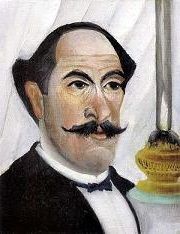
Rousseau married his first wife, Clemence Boitard, in 1868. Of their several children, only a daughter, Julia, survived into adulthood. After leaving the regiment he took a job checking goods for the toll authority, which gained him the lifelong nickname of "Le Douanier." During his tenure there, Rousseau completed his first drawings and paintings. The beginnings of his career as an artist are uncertain, but he claimed that he began to paint at the age of forty (1884), which corresponds to the time that he obtained a license to make copies of paintings at the Louvre. His job as a customs officer required only occasional periods of diligence, and it is possible that Rousseau was able to practice drawing during slow periods at work.
Surprisingly, Rousseau expressed the greatest admiration for painters such as Jean-Leon Gerome and William-Adolphe Bouguereau, and strove for recognition from the Académie des Beaux-Arts. Having been rejected from the Salon, however, he exhibited for the first time with the Groupe des Indépendants in 1885. The two paintings chosen for the show illustrate his vacillation between tradition and modernity: Italian Dance depicts a subject popularized by academic painters, while the other, Sunset, handles a theme favored by the Impressionists. In the following year, the Groupe des Indépendants established its own Salon, in which Rousseau participated nearly every year until his death. The first Salon des Indépendants featured Carnival Evening(1886), an early painting that already exhibited the odd, dreamlike quality and compositional arrangement of Rousseau's mature style. Surprised! Tiger in a Tropical Storm (1891), the first of his well-known jungle paintings, was exhibited at the Indépendants in 1891. Contrary to Rousseau's accounts of these works, they were most likely inspired by trips to the Paris Jardin des Plantes and the Museum d'Histoire Naturelle.
Mature Period
In 1889, Rousseau traveled to Paris for the World's Fair, which inspired him to write a play about the experience. The fair was also incorporated into the background of the painting Myself, Portrait-Landscape (1890), which was received by critics with mockery and sarcasm.
Taking early retirement from the customs office in 1893, Rousseau became a full-time painter. War (1894), exhibited at that year's Independants, marked a turning point in his career. The large-scale allegorical painting garnered him his only positive review to date in the journal Mercure de France. It also attracted the attention of the poet and writer Alfred Jarry, who published a lithograph of War in his magazine. Rousseau executed a portrait of Jarry in 1895, which was later destroyed by Jarry himself for the novelty of ruining his own image.
In 1898, ten years after the death of his first wife, Rousseau married Josephine Noury, a widow. Continuing to seek acclaim, he entered two competitions between 1898 and 1900 to paint the town halls of Vincennes and Asnieres, respectively, but failed to win either. Through commentary from the press, however, he came to realize that he had gained a degree of notoriety with his jungle paintings, and returned to the subject with Scouts Attacked by the Tiger in 1904. Its inclusion at the Indépendants prompted numerous reviews, thrusting Rousseau back into the public eye.
It was around this time that the younger generation of artists discovered Rousseau, whose work seemed closely related to the "primitive" art that was becoming popular among many members of the avant-garde. He quickly made friends with a number of these artists, including Georges Braque, Pablo Picasso, Guillaume Apollinaire, and Robert Delaunay. In 1906, Rousseau met Wilhelm Uhde, a German art collector and critic who was instrumental in promoting his work during the last years of his life. Rousseau's career suffered a setback, however, when he was imprisoned for bank fraud in 1907. The series of notes he wrote to the judge petitioning for release, which exaggerated his character and his merits, account for some of the most accurate information on the artist in existence today.
Late Years and Death
Uhde organized Rousseau's first, though unsuccessful, solo exhibition in 1908. In the same year, Pablo Picasso purchased Rousseau's Portrait of a Woman (1895) that he found in a secondhand shop. To celebrate his acquisition, Picasso hosted a now-legendary party that inspired colorful written accounts by many of the guests, including Gertrude Stein. As the guest of honor, Rousseau sat in a throne improvised from a chair raised onto a packing crate, and even added to the entertainment by playing a waltz he had written and named for his first wife. In spite of his popularity among his fellow artists, Rousseau continued to be seen as a figure of amusement in the art world, and lived in poverty for the rest of his life. He died in 1910, suffering from an infected leg wound and despondent over the rejection of his romantic overtures by Leonie, a shop assistant.
The Legacy of Henri Rousseau
Rousseau's friends and fellow artists played an important role in promoting his legacy immediately after his death. The artist Max Weber introduced Rousseau's work to American audiences with a New York exhibition in 1910, followed by a memorial exhibition organized by Robert Delaunay at the Salon des Indépendants the following year. Uhde also published the first biography on Rousseau, which made a profound impression on Wassily Kandinsky, who later purchased two of Rousseau's paintings and included reproductions of his work in the Blaue Reiter Almanac(1912).
Endowed with an oddly appealing strangeness that could evoke mystery within the commonplace and the exotic, Rousseau's oeuvre left an indelible imprint on artists of the next generation and beyond. His work's unschooled technique and sense of childlike simplicity resonated with the "primitivism" embraced by early-20th-century modern artists such as Picasso and Kandinsky, who looked to art forms such as African tribal masks and Russian folk art in their search for a more "primal" means of expression. Rousseau was also hailed as a "proto-Surrealist" by André Breton, for his art's dream-like, absurdist, and metaphysical quality, and use of bright colors and clear outlines, anticipating the oeuvres of Surrealists such as René Magritte and Giorgio de Chirico.
Influences and Connections

-
![Jean-Léon Gérôme]() Jean-Léon Gérôme
Jean-Léon Gérôme ![Leon Bonnat]() Leon Bonnat
Leon Bonnat![Felix Clement]() Felix Clement
Felix Clement
-
![Guillaume Apollinaire]() Guillaume Apollinaire
Guillaume Apollinaire ![Alfred Jarry]() Alfred Jarry
Alfred Jarry![Wilhelm Uhde]() Wilhelm Uhde
Wilhelm Uhde
 Ask The Art Story AI
Ask The Art Story AI